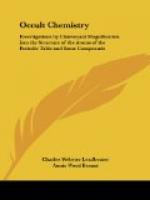losing their limiting walls; the positive body of E
4, on losing its wall, becomes two bodies, one consisting
of the two particles, marked
b, distinguishable
by the linear arrangement of the contained ultimate
atoms, enclosed in a wall, and the other being the
third body enclosed in E 4 and now set free.
The negative body of E 4 similarly, on losing its wall,
becomes two bodies, one consisting of the two particles
marked
b’, and the second the remaining
body, being set free. These free bodies do not
remain on E 3 but pass immediately to E 2, leaving
the positive and negative bodies, each containing
two particles, as the representatives of hydrogen
on E 3. On taking these bodies a step higher their
wall disappears, and the internal bodies are set free,
those containing the atoms arranged lineally being
positive, and those with the triangular arrangement
being negative. These two forms represent hydrogen
on E 2, but similar bodies of this state of matter
are found entering into other combinations, as may
be seen by referring to
f on E 2 of nitrogen
(N). On raising these bodies yet one step further,
the falling away of the walls sets the contained atoms
free, and we reach the ultimate physical atom, the
matter of E 1. The disintegration of this sets
free particles of astral matter, so that we have reached
in this the limit of physical matter. The Theosophical
reader will notice with interest that we can thus observe
seven distinct substates of physical matter, and no
more.
The ultimate atom, which is the same in all the observed
cases, is an exceedingly complex body, and only its
main characteristics are given in the diagram.
It is composed entirely of spirals, the spiral being
in its turn composed of spirillae, and these again
of minuter spirillae. A fairly accurate drawing
is given in Babbitt’s “Principles of Light
and Colour,” p. 102. The illustrations
there given of atomic combinations are entirely wrong
and misleading, but if the stove-pipe run through the
centre of the single atom be removed, the picture
may be taken as correct, and will give some idea of
the complexity of this fundamental unit of the physical
universe.
Turning to the force side of the atom and its combinations,
we observe that force pours in the heart-shaped depression
at the top of the atom, and issues from the point,
and is changed in character by its passage; further,
force rushes through every spiral and every spirilla,
and the changing shades of colour that flash out from
the rapidly revolving and vibrating atom depend on
the several activities of the spirals; sometimes one,
sometimes another, is thrown into more energetic action,
and with the change of activity from one spiral to
another the colour changes.




